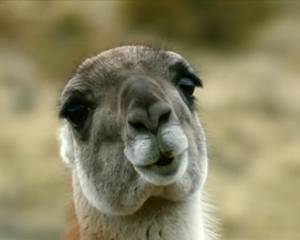No story of Torres Del Paine is complete without that of the herds of guanacos.
托雷德裴恩山的故事里没有羊驼群是不完整的。
A sentinel aims his nose into the wind.
一个哨兵将鼻子探进风里。
Despite being very prolific, with probably half a million of them in South America, guanacos have a unique problem and it makes them adapt in a very specific way.
羊驼尽管繁殖能力很强,南美洲大概有50万只,但它们有一个独特的问题,这使得它们需以一种特殊的方式去适应。
They gather at exactly the right time of day at exactly the right month to start a ritual, to give birth.
他们会在合适的月份里选择合适的一天,并在合适的时间聚集在一起举行一项仪式——生娃儿。
It happens a few hours before midday and a few after in November in the heat each year.
举行这项仪式的时间会在每年11月的一个炎热的中午的前几个小时或者后几个小时。

They fine-tuned this as an adaptation because guanacos have tongues that are just too short to extend beyond their lips so they simply cannot lick a newborn clean.
为了适应,他们将这一时间进行了微调,因为羊驼的舌头太短,无法从嘴里伸出来,所以它们无法把新生的小羊驼舔干净。
Birthing is perfectly timed so he can dry out on his own.
生孩子的时间刚刚好的话,新生的小羊驼就能自己干。
It's a male chulengo and he has just 10 minutes to stand.
这是一只雄性羊驼,他只有10分钟的时间学会站立。
Only one in four of them will make it to their first year through the gauntlet of pumas that live here.
只有四分之一的羊驼能在该地美洲豹的威胁下活过第一年。
It's a tense few hours for the herd.
这几个小时对羊驼群来说很紧张。
But the little chulengo makes the cutoff time, albeit not terribly elegantly, but it's a good start to his next 25 years.
但这只小羊驼成功完成了任务,虽说不是特别优雅,但这对它未来的25年来说是一个好的开始。












